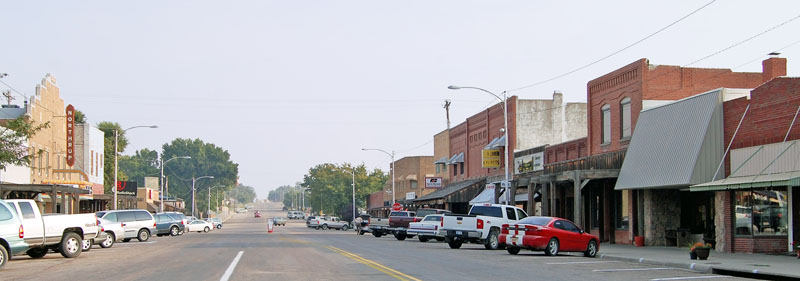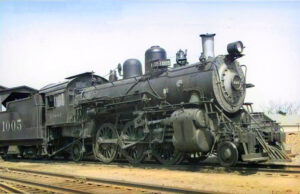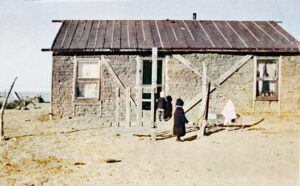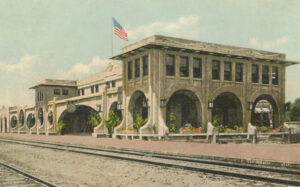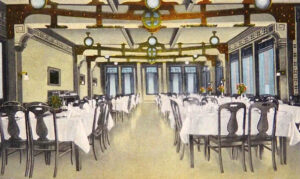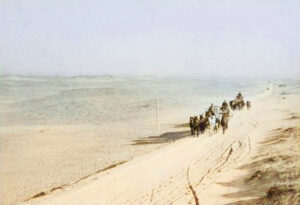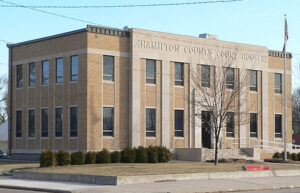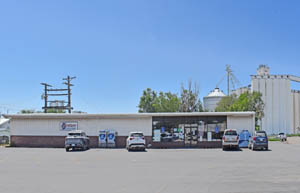Syracuse, Kansas, is the county seat and largest city of Hamilton County. As of the 2020 census, the city’s population was 1,826, and its total area is 4.10 square miles, all of it land.
Syracuse began as a stop on the Atchison, Topeka, and Santa Fe Railroad. The site was initially called Hollidaysburg in honor of Cyrus K. Holliday, the railroad’s first President.
Once the railroad was completed, the company began advertising these lands as prime business and agricultural opportunities all over the East Coast. Hamilton County had over one million acres subject to homestead, preemption, and timber claims. The railroad offered to move the settlers free of charge, and if they were dissatisfied, they would be moved elsewhere.
A group of people from Syracuse, New York, decided to scout the land of Hamilton County. E.P. Barber, D.C. Auckland, and S.R. Jones arrived in Dodge City only to find that passenger service had not yet been established. They rode a railway work train from Dodge City to Hollidaysburg. At that time, the site consisted of a side track and a water tower. Finding countless possibilities, the men returned to New York and convinced 25-40 families to settle there.
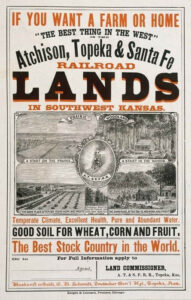
Atchison, Topeka, and Santa Fe Railroad Advertising Southwest Kansas.
The group arrived at Hollidaysburg in March 1873. Soon after settling, the townspeople decided to rename the town Syracuse in honor of their hometown. Over the next few months, dugouts and soddy homes were built for the settlers. E.P. Barber’s house was a frame house that was used as both a residence and a place of shelter for people to go to in case of an Indian attack. Although there were scares, there were no attacks on the townspeople.
A post office was established on May 23, 1873.
The Syracuse Journal began publishing in 1885 and continues to serve as the voice of Hamilton County, Kansas.
In 1886, Syracuse was victorious in the county seat fight, in which Kendall was the opposing candidate.
Syracuse secured its place in American history on April 5, 1887, by electing the first all-woman city council in the nation. The council consisted of Mrs. N. E. Wheeler (mayor), Caroline Johnson Barber, Mrs. W.A. Swartwood, Mrs. S.P. Nott, Mrs. Charles Coe, and Mrs. G.C. Riggles.
Although Syracuse experienced drought and challenging conditions for the next 15 years, it did not fare as badly as most western towns.
The town’s population was 1,200 in 1888. However, it declined in subsequent years, and the population in 1890 was 324. Over the next decade, the worst in the history of that section of the state, it increased to 460.
In 1902, the Santa Fe roundhouse was relocated from Coolidge to Syracuse, a city that would soon experience population growth.
Work on the Sequoyah Hotel and Restaurant, a Harvey House property, began in 1907. It was designed by Louis Curtiss and built of reinforced concrete in the Mission style for $75,000. This chain of hotels and restaurants, dotted at numerous Atchison, Topeka, and Santa Fe Railroad stops serving the American Southwest, began operating in the late 19th century. The Harvey Houses (84 at their height of popularity) were noted for the “Harvey Girls” – young, single women Fred Harvey hired to work in his restaurants. These hotels and restaurants were often credited with helping to bring civility to the country’s southwest. The Sequoyah Hotel opened in 1908 along the tracks of the railroad.
Several large-scale pumping plants have been installed in the vicinity in recent years, and much of the prosperity now enjoyed is attributable to irrigation of farmland.
A new steel bridge was built over the Arkansas River in 1909, and a fine rock road ran through the city, leading to the country on either side. Many of the residents owned automobiles.

Syracuse, Kansas, in 1910.
In 1910, Syracuse was an incorporated city of the third class and was still a station on the Atchison, Topeka, & Santa Fe Railroad. At that time, it was a division point for the railroad and was the principal town in the state west of Garden City. It had two banks, the Sequoyah Hotel belonging to the Fred Harvey Company, a flour mill, several machine shops, two weekly newspapers—the Syracuse Journal and the Republican-News—four churches, a county high school with ten teachers, a telegraph and express office, and an international money order post office. The population in 1910 was 1,126.
During the Dust Bowl years of the 1930s, dust storms were common in western Kansas. Wind erosion was a significant problem during this period, and Hamilton County and a broad area experienced it severely. This catastrophe intensified the economic impact of the Great Depression in the region.
Unfortunately, with passenger transportation on the railroad declining, the Sequoyah Hotel closed in 1936.
The Hamilton County Courthouse was constructed in 1937 under the Public Works Administration. It was designed by C.F. Boucher and H.G. Overend and constructed by Frank E. Blaser. The Public Works Administration supplied a $29,250 grant for the project, which cost $65,007. The two-story, buff-colored brick-and-concrete rectangular structure is located at 219 North Main Street in the center of Syracuse.
The city’s population peaked in 1950 at 2,075.
The once-beautiful Sequoyah Hotel was demolished in 1972.
Syracuse remains one of the most productive areas for wheat, hay, corn, and milo, and feedlots and dairies further support its agriculture-based economy.
Syracuse is located along U.S. Route 50 and the Atchison, Topeka, and Santa Fe Railway, 16 miles from the Colorado border. The Arkansas River runs just south of the city. Sandhills mark the countryside south of the Arkansas River. Located within these sandhills is the “Syracuse Sand Dunes,” a city park covering 1,300 acres, including a 40-acre fishing pond.
©Kathy Alexander/Legends of Kansas, updated December 2025.
Also See:
Hamilton County Santa Fe Trail
Sources:
Architectural Observer
Blackmar, Frank W.; Kansas: A Cyclopedia of State History, Vol I; Standard Publishing Company, Chicago, IL 1912.
Fort Hays State University
Living New Deal
Wikipedia

